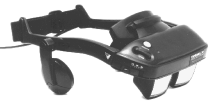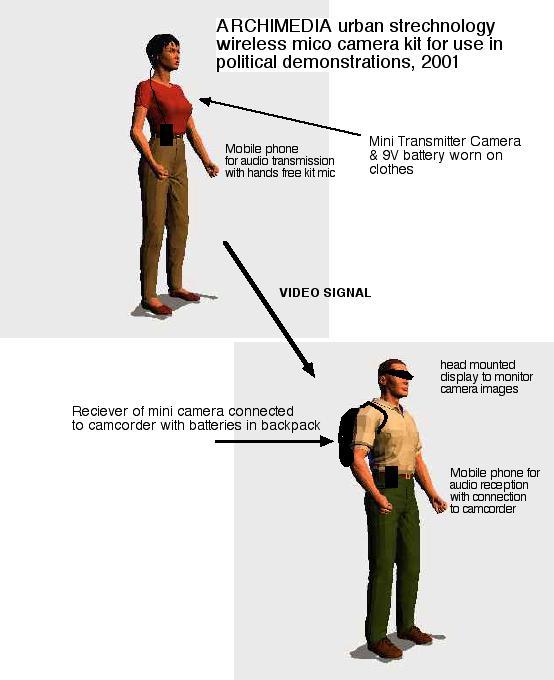
Archimedia
Urban Strechnology Kit
The Urban Strechnology Kit is a set of small media devices which together form a kit which enables two people to become a 'micro-broadcasting' unit. A small wireless surveillance camera, normally used for in-store security is carried around by one person while a second person receives the images and channels them into both a camcorder to record them, as well as a head mounted display.

The Urban Strechnology Kit fits into the broader aims and objectives of the EMU project in that it emphasises the movement through urban space of an individual while he or she is connected to media devices. It is related to earlier wearable computing experiments also in that it makes use of head mounted display technology to enable a person to walk through a city and while doing so, simultaneously make use of dynamic information about that environment.
 |
||
| Virtua I-O glasses
as used in the 'Urban Strechnology Kit'
This head mounted display (HMD) unit is used in my EMU experiments with wearable computers however it can also be used to receive video signals of any type. |
 |
||
How
are images of the real world and non real world combined with the head mounted
display?
When the wearer of the head mounted display looks at the world around her, she sees the real world, with whatever signal is arriving to the head mounted display superimposed. The electronic signal can either be a video signal from a video camera which she is carrying or which someone else is carrying (and having its vision transmitted to the display via radio). The signal can also be a computer signal, either from a computer which she is herself carrying (wearing) or one tethered to a desk in the normal way.
When the wearer of the head mounted display has her view of the world augmented
with signals either from her own or someone elses camera or computer, she
can thus ‘know’ more about the world around her. She is afforded
an additional ‘take’ on that world. For example at demonstrations
where police forbid the use of camcorders, someone can carry a small wireless
camera and transmit this signal to the wearer of the head mounted display
while she is simultaneously recording that video signal. The source of the
video signal and the point at which it is being recorded are separate. The
head mounted display (HMD) acts as the monitor for what the small camera is
seeing.
If the wearer of the HMD uses it to monitor what she is doing with a wearable
computer, the interface to that computer, where it would normally appear on
a monitor on a desktop now appears as a superimposed image over whatever else
she is doing during the day; for example waiting in a queue at the post office,
or walking through the city, or the countryside. Information about where she
is can be called up via wireless internet connection and made available to
her in real time. This is thus ‘proximity specific’ computing.